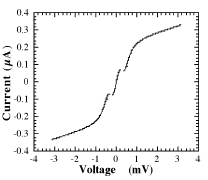Page: 1 2 3
4 5 6
7 8 9
10 11 12
13 14 15
16 17 18
We can make a rough estimate of the effective loop area at the bar from figure
3b. If half of the magnetic flux in the bar is expelled to the loops, the area
added to the effective area will be approximately 0.5 µm x 1.6 µm = 0.8 µm2,
and the total effective area of those loops is 2.1 µm2, compared to
A=1.3 µm2. The calculated period is then 1.3/2.1=0.62, in good agreement with
the measured value of 0.57.
3.3 Current-voltage characteristics
At some magnetic fields the I-Vx and I-Vy curves became
discontinuous. In figure 15 the voltage jumps by 150200 µV, both in the
I-Vx and the I-Vy diagrams. This is of the same order
as the superconducting gap in aluminum,  Al=175 µeV.
Al=175 µeV.
Figure 15. The I-Vx and I-Vy curves at B=-1.26 mT
(f=-0.88). The origin of the discontinuity in the I-Vx and
I-Vy curve at this and several other magnetic fields is still
unclear. At these fields the zero bias resistance R0 increases
slightly. The curves are swept from negative to positive current and the
temperature was lower than 20 mK.
The discontinuous I-V curves appear only around those special peaks in the R0 vs.
frustration diagram. The current at which the discontinuity appear is smallest
at these peaks, increasing at both higher and lower frustrations (figure 16).
Above the critical current of the array (~0.25 µA) the discontinuity disappears.
The I-Vx curve looks like there is a critical current in the loops at the bars
that is almost suppressed at those magnetic fields, but that does not explain
the strange discontinuities in the I-Vy curve.
16
<===Previous page ooo
Next page ===>
My homepage.
 Al=175 µeV.
Al=175 µeV.
